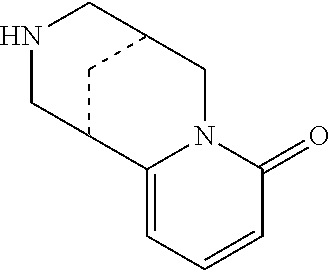Method for Isolation of Cytisine
a cytisine and isolating technology, applied in the field of isolating cytisine, can solve the problems of low purity of cytisine obtained in the above examples, unsatisfactory solution, low yield, etc., and achieve the effect of high yield and purity grad
- Summary
- Abstract
- Description
- Claims
- Application Information
AI Technical Summary
Benefits of technology
Problems solved by technology
Method used
Image
Examples
example 3
[0007] Preparation of Cytisine by acid methanol extraction of milled seeds of Golden Chain tree (Cytisus laburnum L., Golden chain) As in Example 1, the milled seeds of Golden Chain tree (Cytisus laburnum L.) are extracted with 70% ethanol acidified with sulfuric acid, instead of acid methanol. The acid aqueous concentrate, purified with chloroform is alkalized according to Example 1, with 25% of ammonium hydroxide solution to pH 11, then it is extracted six times each with 25 L of chloroform. The obtained chloroform extracts further are treated as in Example 1. 125 g of Cytisine HPLC grade of 98, 7% and yield of 83% are obtained.
example 4
[0008] Preparation of Cytisine by acid ethanol extraction of milled seeds of Golden Chain tree (Cytisus laburnum L., Golden chain) As in Example 1, the milled seeds of Golden Chain tree (Cytisus laburnum L.), are extracted with acidified with sulfuric acid 70% ethanol instead of acid methanol. The acid aqueous concentrate is purified with chloroform using 40% of sodium hydroxide solution to pH 11, then it is extracted five times each with 25 L of chloroform. The obtained chloroform extracts further are treated as in Example 1. 120 g of Cytisine HPLC grade of 98.3% and yield of 80% are obtained.
example 5
[0009] Preparation of Cytisine by acid methanol extraction of milled seeds of Golden Chain tree (Cytisus laburnum L., Golden chain) 15 kg of milled seeds of Golden Chain tree (Cytisus laburnum L.) are extracted three times each with 45 L of acidified with 1.09 L of hydrochloric acid 80% ethanol, for 5 hours at pH 2.5-3.0 and temperature of 28° C. The combined alcohol-aqueous acid extracts are concentrated under vacuum to a volume of 20 L, the acid concentrate is filtered, then it is extracted twice each with 10 L of methylene chloride at pH range of 2.5-3.0. The acid purified aqueous concentrate is alkalized with sodium hydroxide to pH 11, then it is extracted six times each with 20 L of methylene chloride. The combined organic extracts are subjected to distillation till the methylene chloride is completely eliminated and to the obtained residue is added 2 L of ethyl acetate to obtain ethyl acetate suspension, stirred it at 5-10° C. and allowing to stay at rest for 10 hours, then th...
PUM
 Login to View More
Login to View More Abstract
Description
Claims
Application Information
 Login to View More
Login to View More - R&D
- Intellectual Property
- Life Sciences
- Materials
- Tech Scout
- Unparalleled Data Quality
- Higher Quality Content
- 60% Fewer Hallucinations
Browse by: Latest US Patents, China's latest patents, Technical Efficacy Thesaurus, Application Domain, Technology Topic, Popular Technical Reports.
© 2025 PatSnap. All rights reserved.Legal|Privacy policy|Modern Slavery Act Transparency Statement|Sitemap|About US| Contact US: help@patsnap.com

